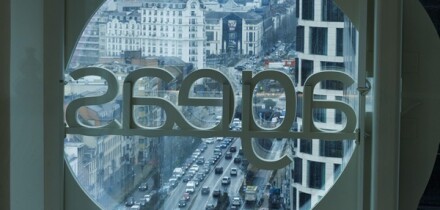Synthetic collateralized mortgage-backed securities are tools for harnessing and exploiting commercial mortgage and real-estate expertise. Using synthetic CMBS, an investor can gain leverage for aggressive speculation or apply sophisticated hedging strategies to manage risk.
One example of a basic synthetic CMBS is a credit-default swap that references an actual CMBS class. This type of synthetic CMBS allows an investor to take exposure to a CMBS class that may be unavailable in cash form because others own it. This type also permits increased investment leverage through unfunded transactions, where an investor can assume the risk of owning a CMBS without paying-in principal at the inception of the trade, i.e., the investor sells protection on the credit risk of the CMBS. This type of synthetic CMBS also facilitates shorting by allowing an investor to buy protection.
Another example of synthetic CMBS--but one that has not actually occurred yet--is a derivative contract that references commercial mortgage loans held by third parties but for which information is readily available. This kind of structure allows an investor to create a customized synthetic pool, representing exposures to loans that may have been included in different CMBS deals in the past. The actual loans may have been originated over a span of many years by different lenders. Such a trade permits an investor to artificially construct a pool of credit exposures that might be impossible to obtain in cash form.
A third example of synthetic CMBS is a multi-layered derivative in the form of a synthetic resecuritization of CMBS. Such a structure resembles a static, synthetic CDO that references CMBS or other commercial real-estate assets. The resecuritization layer does not actually own its underlying reference credits. Rather, it is a derivative contract that refers to them. Moreover, the underlying reference credits themselves may be synthetic. A synthetic CMBS resecuritization allows an investor to customize the pool of reference obligations to which he takes exposure and also to fine tune the leverage on that exposure. One way for an investor to gain leverage is to use mezzanine and subordinate CMBS tranches as the underlying reference credits. The investor then further fine-tunes leverage by choosing the attachment and detachment points for his tranche in the resecuritization structure.
The "Synthetic" Side Of Synthetic CMBS
Single-name CDS on CMBS
A CDS on a single CMBS tranche is reasonably straightforward. The International Swaps and Derivatives Association supplies model documentation for CDS on CMBS. The ISDA documentation includes several samples of alternative language specifically tailored for CMBS. In a typical application, the parties to a CDS on CMBS would select the following options in the standard form:
Interest shortfall cap: applicable
WAC cap interest provision: applicable
Step-up provisions: not applicable
Interest shortfall cap basis: fixed
This choice of options gives the protection buyer limited protection for interest shortfalls other than ones that occur because of weighted-average coupon caps in the underlying reference CMBS. Significantly, reimbursements of servicing advances have been a notable cause of interest shortfalls in CMBS deals and the protection buyer receives limited protection for those shortfalls. The maximum protection that the buyer can receive in any period is the amount of the premium payment under the CDS during that period, i.e., the fixed cap.
A CDS-CMBS transaction between a Wall Street firm and its customers generally would use the ISDA form of documentation with few, if any, alterations. In contrast, CDS-CMBS transactions between Wall Street firms are more likely to have customized provisions negotiated by the parties. For example, a customized transaction might delete the normal provisions allowing physical settlement at the option of the protection buyer.
Synthetic CMBS Resecuritization
A synthetic CMBS resecuritization is essentially a synthetic CDO that references a static pool of CMBS. In such a deal, the underlying portfolio is synthetic. The main risk that investors take in a synthetic CMBS resecuritization is through its reference portfolio. For investors in the deal, the occurrence of a credit event under any CMBS in the reference portfolio essentially has the same effect as if the deal had purchased a bond that subsequently defaulted.
Like most structured financings, a typical synthetic CMBS resecuritization uses credit tranching to create multiple classes of exposure to the underlying reference pool. Each class has different relative seniority to the others and is defined by an attachment point and a detachment point. The attachment point denotes the level of losses--expressed in percentage terms--at which a tranche would suffer its first dollar of loss. The detachment point for a tranche denotes the level of losses on the reference pool at which the tranche will be completely wiped-out.
A synthetic CMBS resecuritization can be executed in either funded or unfunded forms. In the funded form (see fig 1), investors purchase actual notes and receive interest payments. The interest payments can be viewed as consisting of two parts: (1) a riskless return on the invested principal e.g., LIBOR and (2) a spread corresponding to the premium for taking credit risk on the reference portfolio. Losses allocated to an investor's tranche reduce the principal of his note.
In the unfunded form (see fig 2), an investor--the seller of protection--does not deliver principal at the inception of the trade. Rather, the investor promises to make protection payments if losses are allocated to his tranche in the future. Because the unfunded investor does not deliver principal, the periodic payment that he receives consists solely of a premium for taking risk. Thus, if a funded investor would receive LIBOR plus 65 basis points on a given tranche, an unfunded investor in the same tranche likely would receive simply 65 bps.
Typical Synthetic Deal Structures
During the past six to nine months, several dealers have issued synthetic CMBS resecuritizations that reference pools of CMBS at varying levels of credit quality ranging from subordinate CMBS tranches rated BB through senior tranches rated AAA with credit enhancement of 30%. We have observed synthetic CMBS resecuritizations that have reference portfolios composed of 30 to 80 CMBS securities with aggregate notional balances between a few hundred million and a few billion dollars. Most of the deals have a call provision that allows the issuer to call particular tranches between three and five years after the closing date. Some deals issue full capital structures, creating and issuing an aggregate amount of securities that roughly equals the full notional balance of the reference pool. Other deals issue only selected tranches in a manner similar to a synthetic, single-tranche CDO.
Conclusion
Synthetic CMBS offer exciting opportunities for investors with the requisite knowledge and expertise. The challenge is that working with synthetic CMBS demands expertise in both commercial real estate and derivatives.
Although it has not yet happened, we expect the most sophisticated use of synthetic CMBS will come from the creation of synthetic loan portfolios. That application would allow investors to fine-tune the underlying risk of a loan portfolio based on geographic and property-type diversification. That application arguably would allow an investor to optimize his exposure based on his outlook for both the stand-alone risk of different property types and geographic areas and the correlation of risk between different property types and area.
This week's Learning Curve was written by James Manzi, Diana Berezinaand Mark Adelsonanalysts at Nomurain New York.





